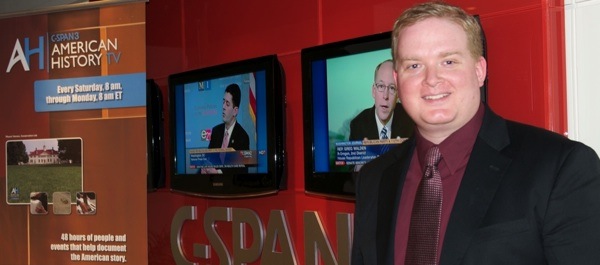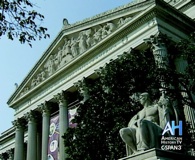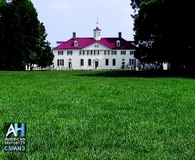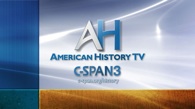
Luke Nichter is the Co-Executive Producer of American History TV, which airs every weekend on C-SPAN3 from 8:00am Saturday ET to 8:00am Monday ET. The program is described by C-SPAN as “a full 48 hours of people and events that help document the American story.”
Doctor Nichter brings a superb background to C-SPAN’s new history offering, combining his training as a historian with work on Capitol Hill and an interest in digital technology. He taught at Bowling Green State University and Texas A&M University. Prior to that he was a staff member for the U.S. House Committee on House Administration in Washington, D.C., and a research assistant for a British Member of Parliament, in London. He also maintains the world’s most complete digitized collection of the Richard Nixon tapes, available at the Website nixontapes.org.
Recently, he spoke with HistoryNet about his work with American History TV.
HistoryNet.com: American History TV sounds like a great idea, especially for history enthusiasts like those who visit HistoryNet and who read our magazines. Would you give us an overview of what sort of topics the program covers?
Dr. Luke A. Nichter: American History TV will focus on the American story, from the nation’s founding to the late Twentieth Century, which gives us a pretty broad canvas on which to paint. We’ve got programming coming up in our lineup on everything from the initial encounters between Native American and the European settlers to 9/11.
HN: What was the philosophy behind this programming? What are you and C-SPAN hoping viewers will take away from watching American History TV?
Our niche will be history programming in first person.
LAN: C-SPAN has offered special features and series about American history for the past 20 years. About two years ago, the network decided to make a deeper ongoing commitment and create a “network-within-a network” on C-SPAN 3 entirely focused on American history. AHTV will offer history enthusiasts a first-person viewing experience for events, people, and places that detail aspects of America’s three-hundred-year story.
HN: What will the nature of the programming be like? Will it primarily be interviews, reenactments, archival footage, or what?
LAN: The best way to give your readers a sense of our content is to detail a few of the regular programs on our 48 hour weekend TV schedule:
 “American Artifacts” takes viewers behind the scenes, to a museum, an archive, or a historic site. There, curators and historians show us artifacts and records that tell the story of that site. Recent programs have included a visit to the presidential yacht, the U.S.S. Sequoia, seeing the recently excavated slave quarters at Monocacy National Battlefield in Maryland, and following the work of the National Archives Recovery Team at a Civil War show in Richmond.
“American Artifacts” takes viewers behind the scenes, to a museum, an archive, or a historic site. There, curators and historians show us artifacts and records that tell the story of that site. Recent programs have included a visit to the presidential yacht, the U.S.S. Sequoia, seeing the recently excavated slave quarters at Monocacy National Battlefield in Maryland, and following the work of the National Archives Recovery Team at a Civil War show in Richmond.
Another ongoing series is “Lectures in History.” We visit the classrooms of top history professors and sit in for their best lecture in American history. Each weekend you’ll see a different professor, at a different university, on a different topic. It’s like going back to college for a day without the tuition.
In addition, each weekend we will feature programming on the American presidency, and we’ll have a dedicated time block for the Civil War, as the nation commemorates its sesquicentennial. We plan to be with this anniversary for the duration: over the next five years, viewers can learn details about the Civil War and its battles as our cameras cover some of the most significant commemorative events across the country.
We don’t anticipate many re-enactments on AHTV, but there will also be lots of film from political archives, interviews with historians, and a wealth of programming about history books and their authors.
HN: In what ways will it be different than other history-themed programming, such as that on History Channel, A&E, Military Channel or PBS?
LAN: The great thing about cable is that it offers many options for interested viewers. Our niche will be history programming in first person—our cameras will take viewers to museums, lectures, symposia and we’ll present content in the “you are there’ format that C-SPAN’s become known for these past thirty years.
HN: How did you become involved in producing American History TV, and what are some of your specific duties as its producer?
 LAN: I came to C-SPAN to launch American History TV. My work with the Nixon tapes demonstrates my interest in the marriage of digital technology and history. This project gave me an opportunity to further that interest and be on the ground floor of a new history programming project—I couldn’t pass it up! My partner for this effort is C-SPAN veteran Susan Bundock, who brings her C-SPAN production and mission experience to my history background. Since May 2010, until the formal launch over the weekend of January 8–9, we built an AHTV staffing unit, a 48-hour programming schedule, an on-air “look,” and have launched several new series that we hope will continue for a long time. Every day brings a new challenge. As a team interested in history, we also have the joy of learning as we work on each weekend’s lineups.
LAN: I came to C-SPAN to launch American History TV. My work with the Nixon tapes demonstrates my interest in the marriage of digital technology and history. This project gave me an opportunity to further that interest and be on the ground floor of a new history programming project—I couldn’t pass it up! My partner for this effort is C-SPAN veteran Susan Bundock, who brings her C-SPAN production and mission experience to my history background. Since May 2010, until the formal launch over the weekend of January 8–9, we built an AHTV staffing unit, a 48-hour programming schedule, an on-air “look,” and have launched several new series that we hope will continue for a long time. Every day brings a new challenge. As a team interested in history, we also have the joy of learning as we work on each weekend’s lineups.
HN: We have to ask: how did you come to possess the world’s most complete digitized collection of the Richard Nixon tapes?
LAN: I fell into that opportunity. It wasn’t planned. When I started researching the tapes as a graduate student, I knew there had to be a better way than to travel to the National Archives’ College Park, Maryland, facility and listen to cassettes. That was the only way they could be accessed. If you wanted copies, you had to bring blank cassettes. Where do you buy blank cassettes today?
With a fellow historian and colleague, Dr. Richard A. Moss, I spent several years digitizing approximately 2,000 hours of currently declassified tapes (out of 3,700 hours total), designed a Website, and then uploaded the nearly three terabytes of content. (Editor’s note: One terabyte equals 1,000,000,000,000 bytes—characters—or approximately 1,000 gigabytes.) The effort has been worth it: The site receives over 100,000 hits a year, and the content has been used in numerous documentaries and memoirs of former Nixon administration figures.
HN: Thanks for taking time to talk with us. Is there anything you’d like to add?
 LAN: Yes. I’d like to explain how people can watch us and how they can help AHTV grow: We often hear from C-SPAN viewers who say they do not have C-SPAN3, which is currently available in about 41 million households. The best thing they can do to help grow that number is to contact their cable or satellite company and ask for C-SPAN3. Meanwhile, our programming is also streamed live and past programs are available in the C-SPAN Video Library, both available at www.c-span.org.
LAN: Yes. I’d like to explain how people can watch us and how they can help AHTV grow: We often hear from C-SPAN viewers who say they do not have C-SPAN3, which is currently available in about 41 million households. The best thing they can do to help grow that number is to contact their cable or satellite company and ask for C-SPAN3. Meanwhile, our programming is also streamed live and past programs are available in the C-SPAN Video Library, both available at www.c-span.org.
Finally, as we launch this service, we’d really like to hear from folks like your readers about how we can continue to evolve it and make it better. We’ll take suggestions for events we might cover, hear about history professors whose classes might be featured on “Lectures in History,” and seek feedback on our overall offerings. I encourage your readers to watch us for awhile and e-mail comments and suggestions to us at americanhistorytv@c-span.org.




